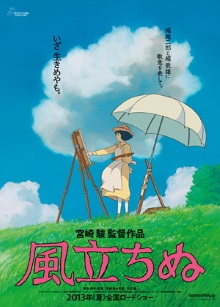
Since The Wind Rises is not only a Studio Ghibli release but also supposedly Hayao Miyazaki’s last film (though this is doubtful since he has repeatedly announced his retirement and then reneged on it), there was zero doubt that we would eventually watch this. This film has also attracted considerable controversy since it could be interpreted as being laudatory towards a man who helped build Japan’s war machine during the Second World War. This of course only makes it even more of a must watch.
The Wind Rises is a highly fictionalized account of the life of Jiro Horikoshi, the designer of the Mitsubishi A5M and its successor the A6M. This latter is better known as the Zero, for a time heralded as the finest fighter plane in the world and the weapon with which Japan savaged Pearl Harbour and conquered Southeast Asia. Yet according to this film, Horikoshi created this plane not to help satisfy Japan’s militaristic ambitions, but simply to fufill his life-long dreams of flight. Unable to be a pilot himself due to his poor eyesight, he is moved instead to create beautiful, wonderful planes, as an expression of his art.
And of course, in the hands of the masterful Miyazaki, this is a mesmerizing tale. In the world of dreams, Horikoshi finds common cause with the Italian aircraft designer Giovanni Caproni who created the fantastic and utterly impractical Caproni Ca. 60. In the waking world, he assiduously pursues his studies of aeronautical engineering and travels the world to gain knowledge and experience to prepare himself to make the plane of his dreams into reality.
Intersped are scenes of the Japan of the period. The depiction of the Great Kanto Earthquake of 1923 leaves one awestruck. Mizayaki reminds us of how embarrassed the Japanese were to be so technologically far behind the West and how much they had to sacrifice in order to catch up. The completely invented love story between Horikoshi and Naoko may be shallow but it is hard to deny that it is effective. The film draws together elements from history, literature and pure imagination to forge a narrative as magical as Horikoshi’s dreams.
All this is portrayed wonderfully with traditional hand-drawn art which feels so much more naturalistic and expressive than the 3D animation we are more used to these days. The pacing and writing are just as good. It is especially impressive how the film can both capture the proper sense of scope and the passage of time, while conveying the richness of the themes it encompasses.
Yet for all that Mizayaki asserts that this film does not represent a break with his habitual pacifism and that the dreams of this fictional version of Horikoshi at least are innocent, it doesn’t feel as if the critics are completely wrong either. There must be an incredible degree of narcissism in Horikoshi to go on to build his beautiful plane all the while knowing that it is useful only as a weapon. And it is uncomfortable how the film bemoans Japan’s losses while being silent about the devastation Horikoshi’s planes have wrought on the victims of Japanese aggression.
To be fair, Miyazaki himself acknowledges this contradiction. To him, the Zero is something that Japan should be proud of as a technological and artistic achievement even as Japan’s militarism should be condemned. And perhaps it is also because the film embraces this contradiction that helps make it so good. Either way, this is an excellent film that once again shows the rest of the world that cartoons don’t have to be just for children.